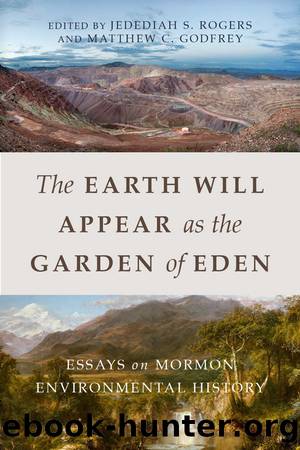The Earth Will Appear as the Garden of Eden by Unknown

Author:Unknown
Language: eng
Format: epub
ISBN: 9781607816546
Publisher: University of Utah Press
âTHERE ARE MILLIONS OF ACRES IN OUR STATEâ
Mormon Agrarianism and the Environmental Limits of Expansion
Brian Q. Cannon
AMERICANS HAVE A LONGSTANDING AFFINITY for agriculture as a wellspring of character and democracy. Thomas Jefferson famously articulated American perceptions of the link between a virtuous citizenry and farm life when he wrote, âThose who labor in the earth are the chosen people of God, if ever he had a chosen people, whose breasts he has made his peculiar deposit for substantial and genuine virtue.â Jefferson believed that small-scale farming fostered industriousness and resourcefulness. Due to their economic self-sufficiency, he reasoned, yeoman farmers were more likely to resist political bribery or coercion.1
Mindful of the Biblical commission to Adam and Eve to till the soil, many Latter-day Saints born in the nineteenth century espoused Jeffersonâs affinity for farming. âIf you want virtue, go into the farming country,â advised Apostle Heber C. Kimball in 1857. Apostle John A. Widtsoe articulated the Jeffersonian bias when he proclaimed, âStrength, vitality and power, and rich form of living come to those who deal with the earth as the Lord gave it to man.â Many Mormons regarded farm life as the ideal laboratory for nurturing religious faith, morality, and industriousness. Church president Heber J. Grant declared, âThere seems to be strength, physical, moral and religious, which comes to those engaged in cultivating the soil, which, on an average, is far superior to that of any other occupation.â2
Mormonsâ conviction that agriculture was ennobling and divinely ordained intertwined with their belief that God had tempered the Great Basin climate to enable the Latter-day Saints to farm there. Thus abundant agricultural harvests in the Mormon heartland reified the Latter-day Saintsâ special relationship to God. Broader cultural convictions undergirding American agricultural expansionâincluding the notion of divinely ordained manifest destiny and the belief that rain would providentially follow the plowâreinforced the Saintsâ perceptions of divine approbation. Combining these strands, Mormon settler and autobiographer William Farrington Cahoon asserted that Providence âmade the wilderness we came to inhabit to blossom as the rose,â proving that God was the Latter-day Saintsâ âfriend.â Similarly, Nancy Tracy, who trekked west in 1850, credited âGodâs blessingâ with the transformation of the Salt Lake Valley from a âbarren desertâ into âfine orchards and beautiful dwellings.â Some asserted that God had extended the growing season in Utahâs mountain valleys. Edward Phillips, who established a farm east of the Great Salt Lake in 1850, recalled, âAt the time of my first settling here, we could not raise a peach tree, but the elements are so softened that now we can raise any kind of fruit.â Similarly John Taylor reminisced in 1865, âRemember the time when we could not raise peaches to eat, and it was a doubt whether an apple tree would grow or not?â The climate had been too unpredictable, the killing frosts too frequent. But God âblessed the elements for our sakes, and also the earthâ to the point where âthere is not a better peach growing country in the world than this.
Download
This site does not store any files on its server. We only index and link to content provided by other sites. Please contact the content providers to delete copyright contents if any and email us, we'll remove relevant links or contents immediately.
Machine Learning at Scale with H2O by Gregory Keys | David Whiting(4121)
Never by Ken Follett(3767)
Fairy Tale by Stephen King(3198)
The Man Who Died Twice by Richard Osman(2982)
Reminders of Him: A Novel by Colleen Hoover(2931)
Will by Will Smith(2772)
Rationality by Steven Pinker(2276)
It Starts With Us (It Ends with Us #2) by Colleen Hoover(2178)
Can't Hurt Me: Master Your Mind and Defy the Odds - Clean Edition by David Goggins(2165)
Friends, Lovers, and the Big Terrible Thing by Matthew Perry(2102)
The Becoming by Nora Roberts(2067)
The Stranger in the Lifeboat by Mitch Albom(2035)
Love on the Brain by Ali Hazelwood(1939)
New Morning Mercies: A Daily Gospel Devotional by Paul David Tripp(1866)
The Strength In Our Scars by Bianca Sparacino(1768)
HBR's 10 Must Reads 2022 by Harvard Business Review(1765)
A Short History of War by Jeremy Black(1745)
Never Finished: Unshackle Your Mind and Win the War Within by David Goggins(1626)
515945210 by Unknown(1585)
